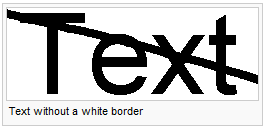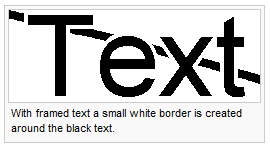Create a New Text Symbol
You can create text symbols with OCAD. The following options are available:
- General: Used to define the font color, type and size.
- Paragraph: Used to define the paragraph attributes
- Tabulator: Used to define the tab attributes
- Line Below: Used to define the underscore attributes
- Framing: Used to define the framing and combination with point symbols
- Select New in the Symbol menu.
- Select the symbol type Text Symbol. The Text Symbol dialog box appears.
- Enter a number between 0.001 and 999999.999 in the Symbol number field and a symbol description in the Descriptionfield.
- Click Edit. The symbol editor appears.
- If required, configure the options 'general', 'paragraph', 'tabulator', 'line below' and 'framing' for the text symbol.
- Once you have defined the Text Symbol, select Icon in the dialog window. The Edit Icon dialog window appears.
- Draw the icon in the 22 x 22 pixel matrix field using the various drawing tools.
- When you are finished, click OK twice. The new symbol appears in the symbol field.
![]() For every text style, a separate symbol is required. If you modify the text symbol, then all text written with that symbol will change. See also Symbols (basic principles).
For every text style, a separate symbol is required. If you modify the text symbol, then all text written with that symbol will change. See also Symbols (basic principles).
![]() The error message: "Font not found" appears if a font is chosen that is not installed on the PC. The font needs to be installed on the PC or another font must be chosen. Otherwise the font Arial is used.
The error message: "Font not found" appears if a font is chosen that is not installed on the PC. The font needs to be installed on the PC or another font must be chosen. Otherwise the font Arial is used.
General
Choose this page to define general text symbol parameters.
- Symbol no.: Enter here a number between 0.001 and 999,999.999 for the symbol. Each symbol in a given map requires a unique number.
- Description: Enter here a description for the symbol. The description is displayed when selecting the symbol or when selecting an object with that symbol.
- TrueType Font: Choose a font for the text symbol. All TrueType fonts installed in Windows are listed. You cannot use raster fonts or Adobe Type Manager fonts.
- Color: Choose the color for the text.
- Size: Choose the size in points for the text. As an alternative you can enter the character height in millimeters in the box Character height.
- Character height: Enter here the height of the character 'B' in millimeters. Alternatively you can enter the size of the font in points in the box Size.
- Bold: Check this box for bold text.
- Italic: Check this box for italic text.
- Drawing mode
This setting is used if you rotate the map with the command Rotate Map in the menu Map.
- Horizontal text: Choose this option if the text shall be rendered horizontal after a rotation of the map.
- Rotated text: Choose this option if the text shall rotate with the map after a rotation of the map.
- Course setting symbol
- (This function is only available in course setting projects!)
- Activate this option if the symbol is used for course titles or start numbers for relay courses.
Paragraph
Choose this page to define parameters for text paragraphs.
- Character spacing: Enter here a distance to be inserted between characters. If you enter 100% a space character is inserted between characters. The default value is 0%. Negative values can be inserted.
- Word spacing: Enter here the distance between words. 100% means that a normal space character is used between words. Default value is 100%.
- Alignment: Choose the alignment of the text.
- Line spacing: Enter the distance from one line to the next within a paragraph, in relation to the font size. Standard value is 120%.
- Space after paragraph: Enter the additional space after each paragraph.
- Indent first: Enter the indent of the first line of each paragraph.
- Indent other lines: Enter the indent of the other lines of each paragraph.
Tab
Choose this page to set the tabs for the text symbol. The tabs are left adjusted. A maximum of 32 tabs can be defined. If a text contains more tab characters than defined in the list, the distance to the last tab is repeated.
- To add a new tab: Enter the position and click Add. The tab is added to the list.
- To delete a tab: Click on the tab to be deleted on the list. Then click Delete.
Line Below
Choose this page to define a line which is drawn below each paragraph. (A paragraph is terminated by a hard return - the Enter key.)
- On: Check this box to get a line below the paragraphs.
- Line color: Choose a color for the line.
- Line width: Enter a line width.
- Distance from text: Enter a distance from the baseline of the text to the upper edge of the line.
Framing
Choose this page to set the parameters for text framing.
- Off: Activate this box if you don't want to use text framing.
- Line: Enter here the width (how much the framing extends outside the character) of the text framing.
- Shadow: Choose this option if a shadow to the text shall be rendered. Enter the horizontal and vertical offset of the shadow. Choose the color.
- Rectangle: Choose this option to add a rectangular background. Enter the values Left, Right, Bottom and Top if the rectangle shall overlap the text. Choose a color.
- Color:: Choose a color. To get text framing, this color must be below the color of the main font in the color table, but above the colors of any objects which you wish to cover.
- Point symbol: Check On if you want to attach a point symbol to the text symbol. Choose a point symbol.
Text framing is a method to make text more readable on maps. If - for instance - you have black text on a map, it may interfere with black line objects. Text framing can also be used for decorative effects - giving the text a shadow, for instance.
For text framing you need to understand the color table and you should have some experience in creating new colors and new symbols.
First you need two additional colors which are above the black color for symbols:
Then you can add text framing to an existing text symbol:
- Right click the text symbol and choose Edit from the context menu.
- Choose the General page. Choose "Black for text" for the text color.
- Choose the Framing page. Activate Line.
- Enter the desired framing width.
- Choose "White for text frames" in the Color box.
Selective text framing
Often text framing erases only the black color, but the other colors still come through. OCAD allows selective text framing for printing the map with spot colors (PMS or Pantone colors), by defining the appropriate spot colors. However, on the screen all colors below the framing color are erased. So beware: the appearance of the map on the screen and the printed map will be different. Selective text framing is also possible for CMYK printing. For this case you have to define your own "spot colors" for CMYK. You cannot use the automatic CMYK color separations.
Choose this page to set the parameters for text framing.
- Off: Activate this box if you want to use text framing.
- Line: Enter here the width (how much the framing extends outside the character) of the text framing.
- Shadow: Choose this option if a shadow to the text shall be rendered. Enter the horizontal and vertical offset of the shadow. Choose a color.
- Color: Choose a color. To get text framing, this color must be below the color of the main font in the color table, but above the colors of any objects which you wish to cover.



